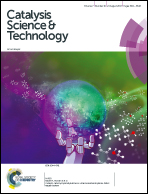The effect of potassium on steam-methane reforming on the Ni4/Al2O3 surface: a DFT study†
Abstract
Steam-methane reforming is a method of converting natural gas to syngas, and the additive K could affect the activity of steam-methane reforming on Ni catalyst supported by Al2O3. In addition, K could release carbon deposition. In the present work, density functional theory calculations were performed to study the reaction mechanisms and catalytic activity of steam-methane reforming on clean and K pre-adsorbed Ni4 clusters supported by Al2O3. Adsorption situations and the reaction cycles for steam-methane reforming reactions on clean and K pre-adsorbed Ni4-Al2O3 clusters were clarified. The rate-limiting step is the dissociative adsorption of molecular methane. K will promote steam-methane reforming through donating electron density and enhancing the activity of Ni by enhancing the overlapping of the orbitals of Ni and C. As a result, the barriers of C–H cleavage in the first two steps of CH4 dissociation on K pre-adsorbed Ni4 clusters are lower than that on clean clusters and thus retain the activity of steam-methane reforming. On the contrary, the barriers of C–H cleavage in the last two steps of CH4 dissociation on K pre-adsorbed Ni4/Al2O3 are higher than that on clean Ni4/Al2O3 and thus K will relieve the carbon deposition, which is in good agreement with the experimental results.



 Please wait while we load your content...
Please wait while we load your content...